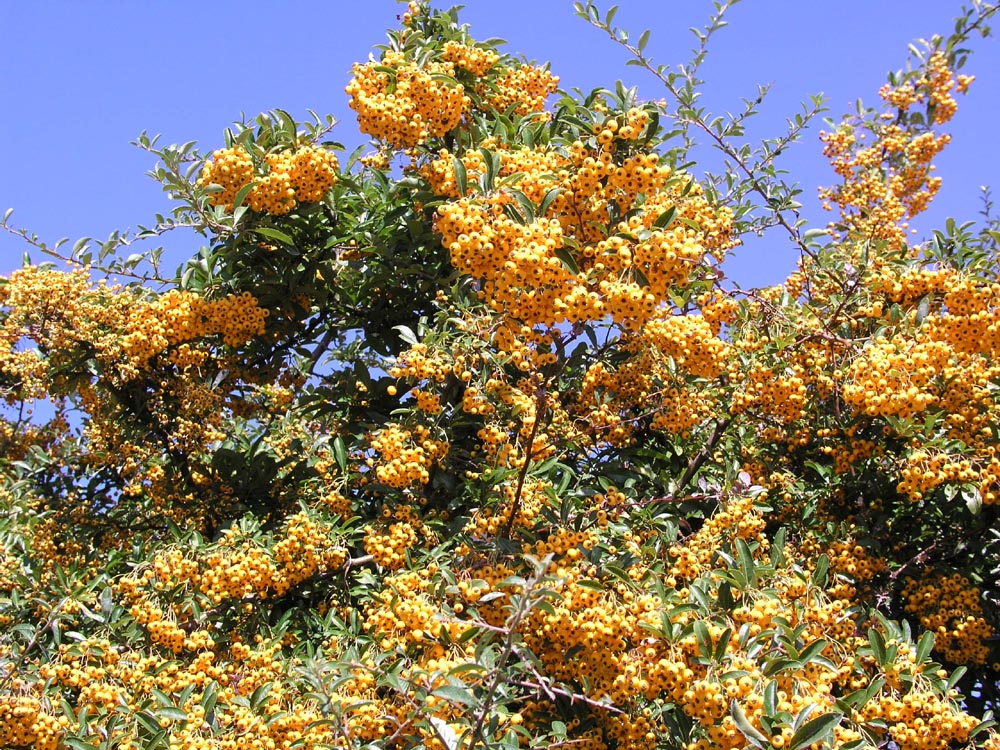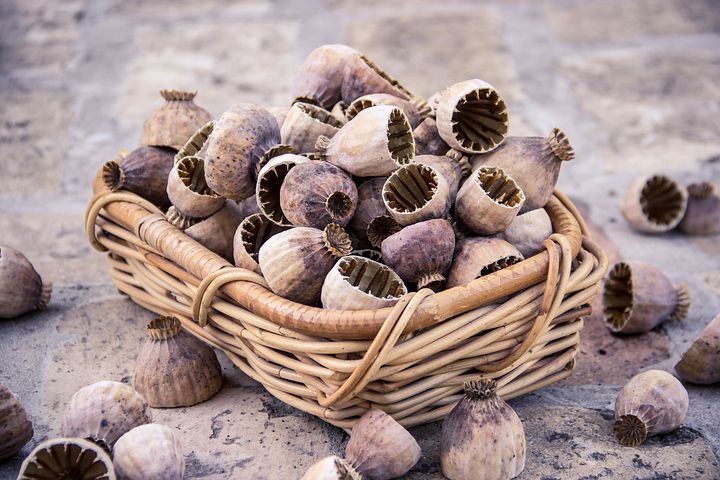By Patricia Jordan
I collect seeds all year round, often sharing them with my gardening friends. The early flowering annuals like poppies and cerinthe have many seeds. Poppies shed their tiny seeds through holes in the tops of the seed capsules, so the stems are best cut off just before this happens and the seeds, looking like grains of pepper, can be shaken into a paper bag. Cerinthe seeds are tucked away amongst its dying flowers, and you have to be quick to catch them in late spring, before they fall to the ground and bury themselves in any loose soil.
From now on there will be the flat seeds from Caesalpinia, encased in hard pods which break open and fling around the garden. As a result, you might find little trees appearing wherever they drop into the flower beds. This may be a bonus or not! The lovely lilac-flowering jacaranda trees produce many large seed pods, looking rather like dried oyster shells and tucked between the outer cases is a seed. Pine trees produce seeds that are hidden inside the various layers of the cones and when the weather is dry and it is breezy, as these seeds are released, they float on their wings in the air until they find some suitable soil in which to grow. Some succulents like Orbea also broadcast their seeds this way.
Other plants produce seeds that are sticky, like plumbago, which catch on to the fur of any animal or the clothing of a human passing by the bush. When brushed off, they will fall to the ground and germinate, eventually producing another plant.
Some plants don’t come true from seeds and are known as hybrids. A hybrid plant is the result of cross-pollinating two different plant varieties and growing on the seed the mix produces. An example of this is the apple ‘pink lady’, whose parents were ‘golden delicious’ and ‘lady Williams’, and the strongest sapling of that union became the apple we enjoy.
Usually, we remove the seed pods of bulbous plants such as daffodils, tulips, hyacinths and much later on, agapanthus, as we want the plant to concentrate on building up the bulb for flowering again next season. Seeds from these plants may take many years to grow and produce flowers. Remember that most seeds need a cold period before they germinate, so if you bought packets of them from a supermarket or garden centre or even collected them in your own garden, pop them into the fridge for a few weeks before sowing, to give them a ‘winter’.

Heavenly perfumed paperwhites
WHAT TO DO IN THE GARDEN THIS MONTH.
Whatever you call this season of mellow fruitfulness, autumn or fall, it is fast approaching, which is a relief for the gardener as well as the garden! In many parts of the northern hemisphere as daylight hours become shorter and night temperatures start to drop, leaves begin to change colour and the first winds and rains of autumn will cause them to flutter down and rest in a thick rusty-golden carpet on the ground below. Here prunus and pecan trees begin to shed their now golden leaves and indeed both need a cold spell to recover from the heat and produce new buds and leaves for next season. Unless there are storms and heavy rain, they will remain on the trees for some time yet. The leaves of the ‘Virginia creeper’, botanical name Parthenocissus quinquefolia, which comes from the Greek, meaning ‘virgin’, is excellent for covering an uninteresting wall with its lovely red autumnal leaves, but once they drop the plant is very boring.
At this time of year spring bulbs start to appear in garden centres ready for you to plant to give you a colourful spring. Your choice will probably depend on whether you grow on a veranda or in a garden. Bulbs grow equally well in pots as in the ground. Amongst my favourite early flowering bulbs are paperwhites. They are an absolute delight to grow and are usually the first to burst into flower. I have many in my garden now, which were first grown in pots and have taken to the borders extremely well. Other daffodils, I have found, also do well in pots and last for several years. Hyacinths perhaps only last for a couple of years and then the flower stems become shorter with less florets and are best discarded.
I wonder if you have tried corms from Gladiolus nana family, nana meaning small. They flower much earlier than the others and some have delightful evening-scented flowers. They are truly beautiful and go by names such as ‘nymph’, ‘blushing bride’ and ‘charm’ and can be left in the ground all year round. Another small gladiolus is tristis with a really exotic perfume. These small gladioli will grow in pots as well as in the garden and are most suitable for veranda gardens, unlike the summer flowering gladioli that can grow very tall and statuesque and tower about other flowers.
It’s amazing that on a small island like this we are able to grow the most diverse spring bulbs. Not all spring bulbs are native to northern Europe, although daffodils were originally found there. Tulips, long associated with Holland, were originally found in the Tien Shan and Pamir-Alay mountains in Central Asia. Various travellers took them to Turkey where they were much prized and then some were later sent on to Holland. Every grower there wanted one and there was ‘tulip mania’ for a while when fortunes were made and lost just as easily, and a single bulb could cost the price of a house. It’s amazing that these bulbs, which long ago grew on rocky mountain sides adapted so well to the sandy polders of Holland, something to bear in mind when planting them. In some parts of Cyprus tulips grow in their natural state and are highly regarded.
A favourite early spring flower of mine is cyclamen, the national flower of Cyprus. Cyclamen cyprium is very special and endemic to this island. Classed as perennials, they come up every year from rough greyish tubers generally growing at elevations above 300 metres and preferring calcareous rocks in woodlands, under banks and trees and steep hillsides. The tubers are dormant during our very hot summers tucked away beneath the earth. Come the autumn the heart-shaped leaves with serrated edges and silver mottlings will start to appear. The generally white flowers, although some are very pale pink, have five up-swept petals and a magenta blotch near the nose. After pollination the flower stems curl up making round pods, which broadcast the seeds when they are ripe, ably helped by ants. Before too long colonies of cyclamen arise from these seeds. They are a delightful addition to the late winter garden and are in flower for several weeks bringing with them a breath of spring.

A huge pyracantha with berries
PLANT OF THE MONTH – Pyracantha
Pyracantha originally came from southern Europe, Turkey and Iraq, and now grows well in many other parts of the world, where the bright branches of berries tumble over walls and fences in many gardens during the late summer and into autumn. An evergreen shrub belonging to the rose family, ‘firethorn’ (the common name of pyracantha) will grow to a maximum of around three metres, preferring a warm, south-facing position to any other. In springtime, many clusters of white or cream flowers appear on the branches, which eventually turn into bright orange, red or yellow berries. These are extremely attractive to birds except the yellow ones, which for some reason they leave well alone. The best-known species is Pyracantha coccinea, which has copious amounts of berries from which it is possible to make a delicious jelly, but there are several other varieties available.
Pyracantha plants don’t relish cold damp soil or cold weather, so choose a non-clay soil in which to plant this shrub, the best site being against a sunny wall, where it can be trained to look its best. If you choose to grow it this way, keep the outward growing flower stems short – about two or three leaves beyond the fruit cluster. Beware of the very sharp thorns when handling them, and always wear heavy gloves to protect your hands and forearms, as some people are allergic to scratches from them. Flowers appear on last year’s growth, so bear that in mind when pruning. Do any positive trimming as the flowers fade, but you will lose some berries that way and you have to be careful trimming so as not remove the buds for next seasons flower. Nature does make it difficult sometimes!
Generally disease-free, they can be susceptible to ‘fireblight’, a fungal disease, caused by growing the shrub in damp conditions. If it happens, prune it out and dispose of the infected branches. Propagate by hardwood cuttings or sow the seeds after giving them a ‘winter’ in the fridge and removing the outer pulp.







Click here to change your cookie preferences